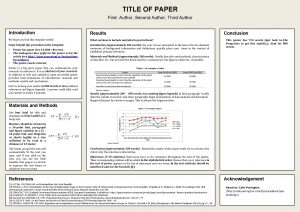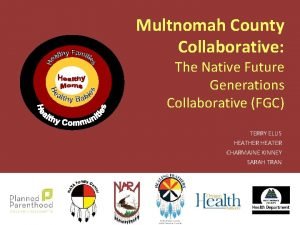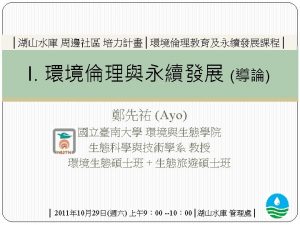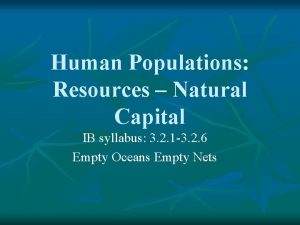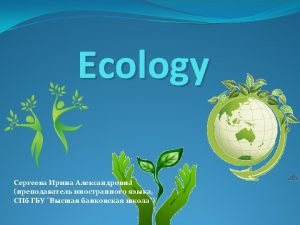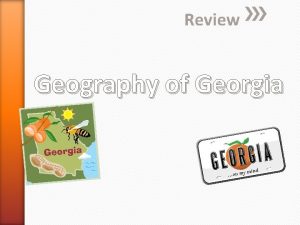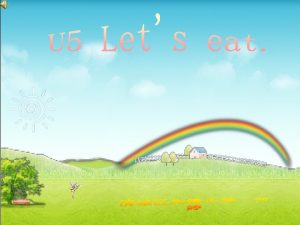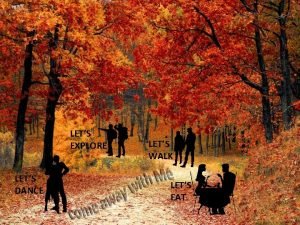Lets preserve it for future generations THE AUTHOR

















- Slides: 17

ØLet's preserve it for future generations… ØTHE AUTHOR: LUDMILA KUDRJASHOVA, ØFORM 10, 2011


Introduction Ø In recent years, many people are talking about conservation. We polluted the seas and rivers, forests and grasslands so much that the situation is terrible. What will future generations inherit? Ø We talk a lot about the world, about how easy to tip the balance in nature, but to restore - it is very difficult. Nature itself is recovering, but very slowly, so people should cherish and preserve the world where they live.

Ø If we poison the land water, then we shall breathe poisoned air and eat unsuitable food. People will start to degenerate into monsters. To avoid this, we must protect the environment. Ø If only everyone could adhere to the purity in his backyard, in the woods, where he walks the company that runs as far as to change everything around you! I hope that people come to their senses, stop destroying the land on which they live.

ØNature reserves and wildlife sanctuaries of Chuvashia Ø The recurrent problem in the densely populated Chuvash republic is to preserve the biological diversity. It is sufficient to maintain the ability of natural systems to self-regulate and counteract the effects of human activities. In order to preserve biological diversity and the formation of sustained environmental framework , a network of specially protected natural territories and objects of the total area of 110, 800 hectares were established in the country : the National Park (25. 2 ha. ), 1 Reserve (9 148 thousand ha. ), 16 nature reserves (total area of 56, 471 ha. ) and 67 natural monuments (6. 646 thousand ha. ). In addition, one botanical garden, dendrology parks function, there is sanitary protection and protected-hunting. Also Chuvashia has 5 genetic reserves (total area of 0. 995 thousand ha. ). 3 of them are specially protected natural territories of federal significance: State Nature Reserve Prisursky (9, 150 hectares), the National Park “Chavash varmane” (25, 2 thousand ha. ) , Cheboksary branch of the Main Botanical Garden RAS (177 ha, collection of more than 2000 species of plants).


The Natural reserve "Prisursky" Ø The State Nature Reserve Prisursky, a total area of 9, 025 hectares, was established in 1995. The reserve was initially created to protect the valley south taiga forests and wetlands with characteristic flora and fauna, in particular for the protection of Desman, seasonal accumulations of water birds. New sections are intended to protect fragments of steppe vegetation with marmots. The main site is located in the valley of the Sura. It was later expanded to create 2 new sites to the east of Chuvashia. Prisursky pine area - a unique biogeocenosis complex. In the northern part overgrown spruce grow, the rest of the territory occupied by pines, birch – trees and aspens. Along with rare species are widely distributed , such as: schitovnik Austrian, moonwort partitioned, members of the family Orchidaceae.


The National Park “Chavash varmane” Ø National Park “Chavash varmane” was established by the Government of the Russian Federation on 20 June 1993 , the total area of 25, 200 hectares. It is located on the southern border of the Chuvash Republic and borders with the Republic of Tatarstan and the Ulyanovsk region. Among the forest zoning of the Chuvash Republic the National Park is the southern boundary of the Prisursky forest. The distinctive feature of the national park "Chavash varmane" is that here on a relatively small area, biocenoses from the southern taiga to the steppe, including the entire ecological range of habitats from dry pine forests to the swamps, are presented. The flora and fauna of the National Park is Extremely rich and diverse. There about 800 species of only vascular plants, among them there are rare and endangered species included in Red Data Book of the Chuvash Republic, nearly all kinds of plants: a mysterious family of orchids, many relic of the ancient flora grow here. They include the bearberry, the golden thoroughwax, the cranberry, the maynik bifoliate, blueberries. . The flora of the National Park is rich and medicinal plants. Widely popular herbs like valerian dosage, galangal (erect cinquefoil), lily of the valley in May, St. John's wort, marjoram grow here in abundance. Totally National Park identified 175 species of birds, 90 breeding, 16 species of amphibians and reptiles, 19 species of fish and 40 species of mammals. As zoologists say the National Park is the home to about 90% of the species composition of vertebrates identified in the Chuvash Republic. The common animals are a squirrel and a hare. Species such as moose, wild boars, beavers, weasels , martens, badgers, foxes and lynxes, not significant, but their number is increasing. An. American mink is well settled down , brought here in 1978. Within the National Park “Chavash varmane “ there are several historical sites that deserve the attention of visitors. They include the place of extraction of iron ore (swamp), extraction of tar and charcoal.




Cheboksary branch of the Main Botanical Garden RAS Ø The idea of organizing the botanical garden in Cheboksary was born in the 50 -ies of XX century. On the general plan of the city in 1957 the border of the garden was first identified. From 1960 to 1978 volunteers performed design and survey works and minor works. In 1978 the present territory of the Botanical Garden's city nursery, was founded. In accordance with the Council of Ministers of the Chuvash ASSR it was organized by an independent unit within the Office of Housing Cheboksary under the name "Office of the green economy. " In 1979 the formation of the park area, sections of the Botanical Gardens, began. In 1980 the first bridges made planting area along the border with the plant of ceramic blocks. In 1983 the Museum of the Botanical Garden and Herbarium was organized. In 1989, due to the increasing importance of issues of environmental stability in the Middle Volga by the Presidium of the Academy of Sciences of the USSR in Cheboksary branch of the Main Botanical Garden of Academy of Sciences was organized. This is the first branch of the Academy of Sciences in the Republic of Chuvashia.

Ø Cheboksary branch of GBS. NV Tsitsin Russian Academy of Sciences (Cheboksary botanical garden) is situated within the city of Cheboksary along the river Kukshumka. The whole area of the botanical garden is divided into scientific, reserved, exposition and administrative and economic areas. Natural forests cover about 90 hectares, water area - 4, 5 hectares of arable land - about 40 hectares. Here is the pond area of more than 5 hectares. Besides the pond and the creek Kukshumka , there are 12 springs, beatings in shady thickets of the parkland. The funds of the botanical garden are the heritage of the federal level. Living plant collections include about 2000 species and cultivars (excluding diversity collections of plants in nature and form). As the botanical garden grow, about 750 species of trees and shrubs, nearly 700 species of flowers, a separate collection of medicinal plants include up to 350 names. More than 600 units represent the flora of Chuvashia. Plants are placed in different parts of the organizational and planning structure garden - in exposition and collectible sites: ornamental plants (650 species and varieties), "The Garden of Padua (570 species), " Medicinal, rare and endangered plants "(342 species), "The Valley of thought" (12 species), "Alpine Slide" (45 species), "Herbaceous flora of Chuvashia (102 species), " Environmental Trail "(14 species), " Arboretum "(600 species), " Frutitsetum (36 species), poplar and willow Russia (23 species and hybrids), "pomology Garden (9 species, 117 varieties).


Rule of conduct in the nature… Ø Don’t disrupt the flowers! Let the beautiful plants be in nature! Ø Plant trees. They will clean the air. Ø Do not break branches from trees and shrubs! Ø Do not catch wild animals Ø Do not catch butterflies, bumblebees, dragonflies and other insects! Ø Don’t ruin the birds' nests! Ø Do not leave your trash in the woods, meadows, on the shore!

 Let's preserve it for future generations
Let's preserve it for future generations First author second author third author
First author second author third author Free robux roblox robux generator
Free robux roblox robux generator Future generations collaborative
Future generations collaborative Sustainable development future generations
Sustainable development future generations How do artists inspire future generations
How do artists inspire future generations Sustainable development future generations
Sustainable development future generations Esercizi future continuous e future perfect
Esercizi future continuous e future perfect Future perfect continuous worksheet
Future perfect continuous worksheet Ecology is the study that helps to preserve
Ecology is the study that helps to preserve Why we must save dying tongues
Why we must save dying tongues Key issue 4: why do people preserve local languages?
Key issue 4: why do people preserve local languages? Purpose of haiku
Purpose of haiku A town has a nature preserve with a rectangular field
A town has a nature preserve with a rectangular field Which statement identifies a reason to preserve wetlands?
Which statement identifies a reason to preserve wetlands? Preserve life in first aid
Preserve life in first aid Great ch
Great ch How to preserve personal memories
How to preserve personal memories

